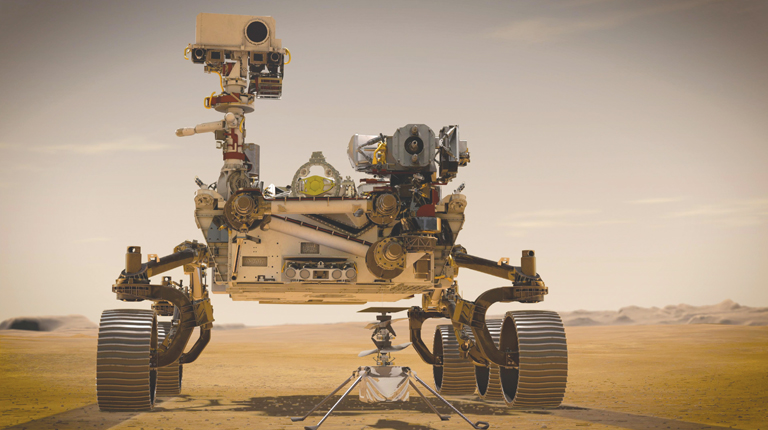
Artist’s rendition of the Perseverance rover and Ingenuity (in front), which are due to launch from Cape Canaveral in Florida on July 30.
By Mary O’KEEFE
The Mars 2020 Perseverance rover mission is set to launch on July 30 from Cape Canaveral Air Force Station in Florida. The launch window opens at 4:50 a.m. PDT. Perseverance is an appropriate name for this next Mars mission as it has had to persevere through a pandemic to make it to the launch pad.
The name Perseverance resulted from a contest among students. There were 28,000 essays submitted to “Name the Rover” contest and Alex Mather of Lake Braddock Secondary School in Burke, Virginia won. In his essay he wrote, “We are a species of explorers, and we will meet many setbacks on the way to Mars. However, we can persevere. We, not as a nation but as humans, will not give up.”
As of Wednesday, Mars 2020 had cleared its Flight Readiness Review, an important milestone on its way to the launch pad, according to NASA.
The Perseverance rover’s astrobiology mission will search for signs of ancient microbial life. It will also characterize the planet’s climate and geology, pave the way for human exploration of the Red Planet, and be the first planetary mission to collect and cache selected samples of Martian rock and regolith (broken rock and dust). Subsequent missions, currently under consideration by NASA in cooperation with ESA (European Space Agency), would send spacecraft to Mars to collect these cached samples from the surface and return them to Earth for in-depth analysis, according to NASA.
The Mars 2020 Perseverance mission is scheduled to land on Feb. 18, 2021 at Jezero Crater. It has a mission of 687 Earth days.
The landing of any spacecraft on another planet has always been that nail-biting time, what Jet Propulsion Laboratory engineers have referred to as the “seven minutes of terror.”
The landing is going to look much like the Mars Science Laboratory Curiosity sky crane landing that used a parachute system but there will be three specific differences. When MSL Curiosity was landing the time to determine when parachutes were deployed was after the landing vehicle achieved a specific speed in the Martian atmosphere, said Keith Comeaux, deputy chief engineer for Mars 2020 and Launch Cruise EDL [Entry Descent and Landing] mission manager.
“On Perseverance we got a little smarter,” Comeaux said. “We now open when we are over our destination.”
Curiosity was the first time a sky crane-type of landing was used. JPL has applied to the Perseverance mission what was learned.
The second difference will be the use of cameras to guide the rover to the safest spot to land.
“Jezero Crater is a dangerous area [in which] to land,” Comeaux said.
The camera will survey the landing from beneath the vehicle. The computer has mapped the dangerous areas and will help guide the vehicle to a safer landing.
The third change also has to do with a series of cameras. These will document the landing. There is a high definition camera at the top of the capsule to capture the opening of the parachute and a similar camera at the bottom of the sky crane to film the rover’s touchdown. And another camera will be directed up at the descent stage as the parachutes are cut away and that portion of the descent vehicle flies away.
If all goes as planned photos of this landing will become as iconic as those of the Eagle landing on the Moon.
This mission has been a bit unusual and challenging due to COVID-19.
“It definitely has been a challenge for the team,” Comeaux said. “I would like to give a shout-out to our team in Florida. Our team has, pardon the pun, persevered through all of the challenges we have had to face.”
Team members did have to change the way they did business to accommodate social distancing. Most of JPL staffers are working from home instead of going into the lab and have conducted their business via video conferencing.
Comeaux will be found practicing social distancing in mission control at JPL on launch day July 30.
